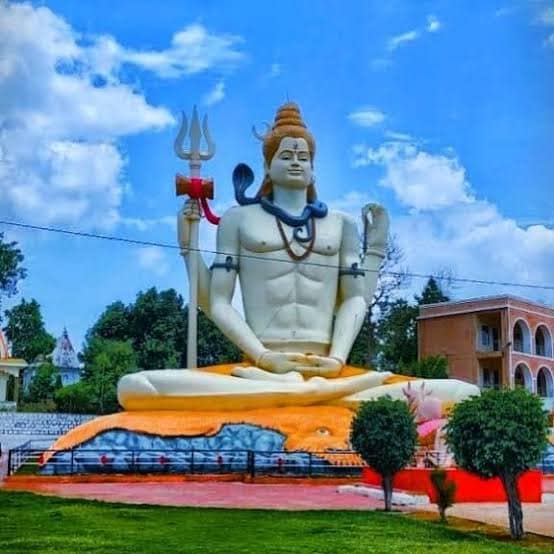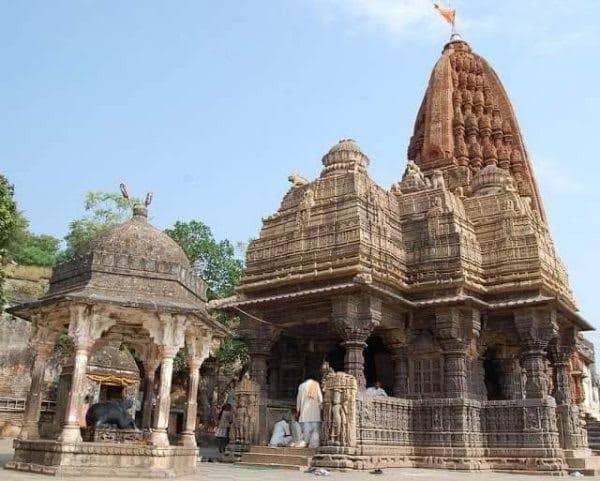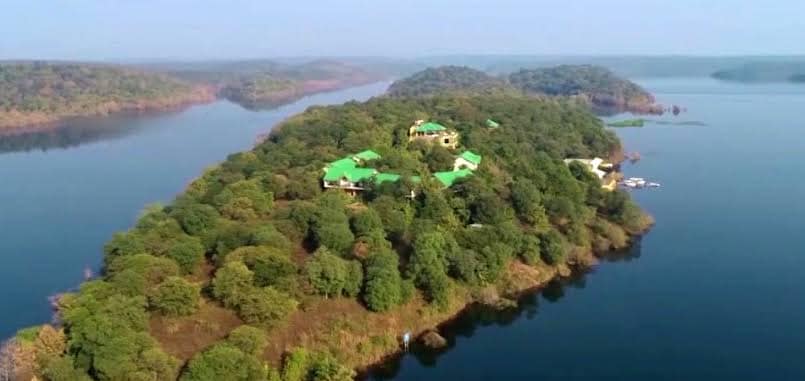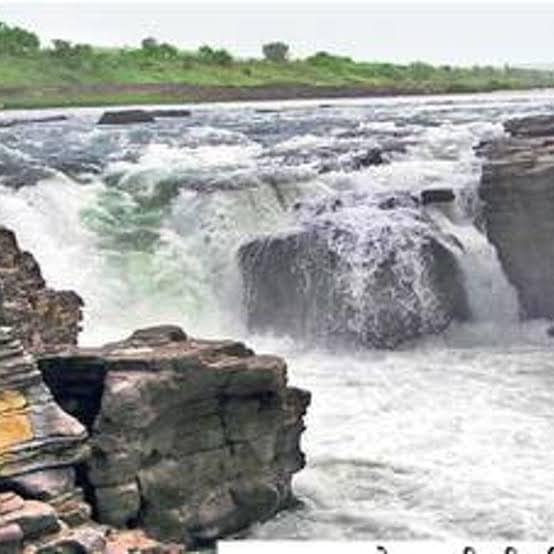After Narmadapuram, on the same banks is located the village of Khoksar, the Samadhi place of Sri Gaurishankar Maharaj, whose role in popularising the practice of Narmada Parikrama had been very significant. Sri Gaurishankar ji Maharaj is said to have possessed great Siddhis (special powers) and Grace of ‘Narmada Maiyya.’ There are stories about him of how he would take Narmada-jal and have pooris made in that when there was no Ghee or oil available. There is a temple complex at the place and stay facility for Parikramavasis. A couple of miles ahead is the Tigadiya Ghat, again having a Dharmashala and a hall for Parikramavasis.

Further downstream, one reaches the Anwarighat, a very important ghat after Budhni on the northern banks – there is another ghat by that name on the southern banks as well. The Anwari Ghat on the southern banks has a very large statue of Lord Shiva and several temples and ashramas. It is said that Pandavas had stayed there and also set up a village called Hastinapur here. There is a still a village ‘by name of Hathnapur’ here, probably an allusion to the ancient Hastinapur. About 12 km north of Anwarighat, mounted on Vindhya hill-top, is the famous Bijasani Devi temple of Salkanpur, visited by hundreds of thousands during the year. Along with Maihar (in Satna district) it is probably the most revered and most visited Devi temple in Madhya Pradesh. There are hundreds of stairs leading to the top, a trolley-car facility which gives a beautiful view, as well as a motorable road.
There are a few more well-known places like the Bawari Ghat on both the banks and Neelkanth (where the river Kolar river meets Narmada – the Kolar river has an extremely scenic dam and reservoir in midst of deep forests just 40 km outside Bhopal city. There is also Ghat at Sheelkanth, and Chhipaner following this on the northern banks. At Chhipaner the river Seep meets Narmada and has a prominent place of the saint Dhuniwale Dadaji.
On the opposite banks, downstream of the Anwarighat is a large and beautifully constructed Ghat at Bhiladia which is in Seoni Malwa tehsil of Narmadapuram district. One has to climb down a very large number of stairs here. There are temples of Sri Rama and Lord Shiva. The Ganjal river, a tributary flowing and meeting the Narmada at the southern banks is nearby.
Opposite to Chhipaner is Chhoti Chhipaner (on the southern banks) and some distance away one reaches the village of Chichot, where the Bajrang Kuti is located. At this place a renowned Yogi of the region, Sri Bajrangdas lived. Later his illustrious disciple Sri Tilak Maharaj too had his base here. Sri Tilak Maharaj was a great scholar and polyglot and knew several European languages. The ashrama now has a nice Veda Vidyalaya that admits children of all castes, something that was not in practice earlier in most traditional Veda Vidyalayas. It also has a fine library, which was mostly the books collection of Sri Tilak Maharaj. Unfortunately, Sri Tilak Maharaj passed away in a road accident when he still had years of active life ahead of him.
Just a little ahead of Chhipaner on the northern banks, one enters the district of Dewas leaving Sehore, with district of Harda (carved out of Narmadapuram) on the opposite banks. The first major ghat as Narmada has Dewas district on the northern banks is Bijalgaon wgich has several temples. Just opposite to Bijagaon is the pllace called where an impressive two-storeyed temple is located. The place also is the Samadhi-Sthal of Ratiram Baba, a revered saint of the region who lived more than a century back. Around this area the river bed at many places is not very deep and for this reason, the folk-lore is that this is where the Mughal armies used to cross over from north to south. It is also the place of a highly revered saint who lived here, Ratiram Maharaj.
After crossing the ghat at Bijalgaon on the northern banks, one arrives at Turnal where the river Gauni meets Narmada. Though a very small village, it has great import since antiquity. It has a temple dedicated to Sri Parasuram, one of the Dashavataras (ten incarnations of Lord Vishnu) and Turnal is considered as a very important place for ‘Pinda-daan’, ‘Shraddha-Tarpan’ and like rituals for one’s ancestors. It was visited by the Dalai Lama in 2017. About a mile ahead is the small but nice ghat at Kundgaon and another mile ahead is the Samadhi of saint Atmaram who lived more than a century back. It is also the place where a tribitary Jamner meets Narmada and is a very scenic place. Just opposite to this the geand temple complex of Shiv Karunadham built by Swami Viyogananda. It has an ashram where many Sadhus stay. Just a mile ahead, one reaches the central point of the Narmada trajectory, equidistant from Amarkantak on one side and the sea on the other. This is the area of Nemawar-Handia, with Nemawar on the northern banks in Dewas district and Handia on the opposite banks in Harda district.
Nemawar-Handia : The mid-point (Nabhi-Sthal)

Nemawar is a place of great eminence in the Narmadakhand. It is said in the Vashishtha Samhita that the ‘Manas-Putras’ of Brahma – Sanaka, Sanatan, Sanandan, and Sanatakumar had done their Tapasya at Nemawar and given Upadesh (spiritual counsel) on the four ashramas (phases) of human life. It has the ancient temple of Siddhanath. Pandavas are also said to have lived here during their twelve year exile. On the opposite bank at Handia is the temple of Riddhanath, and it is said Kuber had done Tapasya here after being displaced by his step-brother Ravana from his Alkapuri. He later won it back. Sri Parashuram’s father – Rishi Jamdagni, and his mother Renuka Devi are also said to have lived in Nemawar. There is a temple dedicated to Renuka Devi in the village. Ahilyadevi Holkar did much for the temple at Nemawar.

Nemawar is the place where two greatly revered Mahatmas of Narmadakhand in recent memory, Brahmachari Viswanath Chaitanya commonly known as Brahmachari Maharaj) and Mungphali Baba, stayed. Both had come to the region from South India. They were widely revered among devotees and Sadhu-Samaj alike. There are several small ashramas and Annakshetras in the area. At Nemawar, the Brahmachari Ashrama (the place where Brahmachari Maharaj lived) serves and accommodates Parikramavasis and near Handia is the Shiva Karunadham tjat has already been mentioned.
For last few decades a widely regarded saint and scholar Sri Shastriji Maharaj has also been living in Nemawar. There is also the Khak-Chowk ashram, a branch-line of the Ramananda Sampradaya, located here. It has a very old Hanuman idol. A very old ashrama called ‘Aloni Ashrama’ (probably named after one Aloni Baba, meaning one who did not take salt) is located and said to have been supported by Ahilyadevi Holkar. It is now called the Dandi Swami Ashrama where a Sansyasi with considerable scholarly reputation, known as the Dandi Swami is based.
There is also a huge Jain temple complex near Nemawar. It was being built for nearly two decades. Opposite to it is a big Dharmashala and Jain monastery. The inspiring force behind the whole development of the complex is the internationally revered Jain Muni Sri Vidyasagar ji Maharaj (known as Acharya Sri.) It is said that many great Jain ascetics in the distant past had done Tapasya in the Nemawar area and attained great heights in their Sadhana. So this area is regarded as a Siddha-Bhumi for Jains too.
Beyond Nemawar-Handia
Just downstream of Handia one encounters a series of Satpura ranges though the Vindhyas on the north recede slightly afar. Here the old Parikrama route on the southern banks that went through Seegone, Uchawan and Joga is no longer used and one has to take a circuitous route around the backwaters of the huge Indira Sagar Dam. However, there are some very scenic locations and ghats on the old route now in disuse. There are villages of Gawla, Maida and Seegon leading to Uchawan. Each of them has beautiful banks with hills and forests on one side. Opposite to Seegone is Rajaur Ghat which has a temple with an idol of Narmada Devi. Just before it, opposite to Maida is the Bagdi Sangam, an ancient place finding a mention in the Puranas. It is also called a Bhairav Siddha Kshetra and the place of union of river Bagdi with Narmada.
On the northern banks one can almost go on the side of the river through villages of Navada, Bajvada, Mandaleswar, Rajaur, Tamkhan and Melpiplya. At Bajvada lived a great saint called Tatambari Baba, and the villagers have built a temple in his honour. The Bagdi Sangam is a mile downstream of Mandaleshwar and both these places have ashramas where Mahatmas stay. The Bagdi Sangam also has a nice ghat. After Melpipilya one has to cross the river Datauni and reach Fatehgarh. One can then walk to Dharmeshwar Mahadev on Satwas-Punasa highway. This temple is situated at a beautiful place with trees aplenty offering respite even from the scorching summer sun. From there one reaches Pamakhedi from where begin the dense forests of Lakkadkot. The temple at Dharmeshwar Mahadev is simple and beautiful with plenty of trees offering respite even from the scorching summer sun.
Near Joga on the southern banks (in Harda district) – opposite to Fatehgarh, there is a small island on Narmada having a fort, called the Joga fort, built by Aurangzeb. One can visit this through a boat frim Joga. So this area was also known as Joga-Fatehgarh to Parikramavasis of a previous generation and still called by that name to the local people.
A little ahead of Joga-Fatehgarh, around 25 km downstream of Nemawar-Handia, start a series of dams that have permanently changed the geography of the region. The Narmada has changed more in last forty years than it perhaps did in preceding forty thousand years or more. The first major dam one comes across is the Indira Sagar Dam, earlier known aa the Narmada Sagar project. Though the Indira Sagar dam is located in Khandwa district its backwaters flow into districts of Harda and Dewas.
The costs and benefits of dams have been widely debated and this is not the space to bring that in. But certainly one sad outcome is the loss of several sites of traditional importance to the Parikramavasis and other devotees in general. About a hundred villages and entire town of Harsud, then having a population of 22 thousand, got submerged in the Indira Sagar project. The rehabilitated township called ‘Naya Harsud’ is at Chhanera on the rim of the backwaters. A segment of the Harda-Khandwa section on Bhopal-Mumbai railroad had to be removed farther away because of the backwaters.
The Indira Sagar has a hydel project under the National Hydel Development Corporation, and also a thermal power plant called Singaji Power Plant – which also uses the water of the dam. The Indira Sagar project has the distinction of having the largest volume of water in its reservoir among all the dams in the country. The township establishment for the dam is called Narmadanagar and is near the Tehsil headquarter of Punasa in Khandwa district. Before the Parikrama routes got changed one had to go through dense forest infested with wild beats known as the ‘Omkareswar Jhaadi.’ Now a Parikramavasi has to circumvent the entire Indira Sagar reservoir on the southern banks almost after Handia and for many days (even for more than a week) is unable to get a sight of Narmada. One passes through Ratatalai, Sontalai, Khirkiya, Chhanera (Naya Harsud), Mundi, and reaches Omkareshwar through a loop which has significantly added to the length of the Parikrama circuit.
On the northern banks, however, the route has not changed much. One has to still pass through deep forests immediately after the village of Pamakhedi. This patch called the Lakkadkot jungle has forests for around 1000 sq km with no human habitation. The perils of the wild are always present in these areas. Earlier, as recent as a couple of decades back, one could even get lost as there were no paths (pagdandis), let alone any pavement or road. There had been anecdotes of people unable to find their way out of the Lakkadkot for days together. On the northern side, a certain narrow stream had to be crossed around twenty times. One had to keep a count to be sure that one is moving ahead in the right direction.
Now a network of kaccha roads run through the Lakkadkot, chiefly towards Jayanti Mata Mandir which is the nerve-centre of this area. One can only see forests as far as one’s sight can take. One wonders how a temple came into existence in such an inaccessible, perilous, and uninhabited area. But then in a land of faith, that India is, there is no dearth of such bewildering instances. The Jayanti Mata Mandir is visited largely by the tribal communities living in tehsils of Udaynagar, Bagli, and Satwas in Dewas district, and Punasa tehsil of Khandwa district. The people usually visit in two wheelers, rented jeeps, or tractor-trolleys – the last mentioned is the most common vehicle in rural India. It is the poor Indians’ SUV and can accommodate dozens of persons. It can be highly dangerous because of poor balance and numerous accidents are reported every year by overturning of these trolleys.
Just half a kilometer down from the Jayanti Mata Temple, gingerly walking through a stony path, one reaches a water stream with water flowing down the rick ceiling of a cave called the ‘Bhairav Gufa.’ All visitors to the Jayanti Mata Mandir visit this place too.
Further westward of the Jayanti Mata Mandir, across the forests one reaches Sitavan. This marks the end of the Lakkadkot. Here is a temple and Kund (water body) and it is believed that Sita ji, along with her sons Lav and Kush had stayed at this place in the Ashrama of Sri Valmiki, the great sage and author of the Ramayana. The place is located near the village of Peepri in Udaynagar tehsil of Dewas district, and is on a good motorable road from Udaynagar and Punjapura, taking a detour on the road to Badwah whixh further takes one to Khandwa and Khargone. The temple is called the ‘Sita Mandir’ where Sri Ramachandra, Sri Sita ji, Sri Lakshmana, Sri Bharat, Sri Shatrughna, Lav, Kush, and Sri Hanuman along with some other characters of the Ramayana are worshipped. The Narmada flows about 5 km from this place and can be approached in the area known as Dharaji at which place were once located the famous waterfalls on the Dhavrikund, now lost for ever in the backwaters of the Omkareshwar dam. A new Dharaji Ghat is being developed here near the village Jamli. From this ghat one can see on the other side the temple of Baneshwar Mahadev amidst dense forests on that side too.

Because of the dams, as already mentioned, the traditional Parikrama routes have changed significantly. On the northern banks one usually goes from Melpiplya (just before Fatehgarh) towards Pamakhedi and moved through the Lakkadkhot forest towards Jayanti Mata Mandir, Sitavan, Dharaji, and then towards the Khedighat region near Barwah. A very significant spot called Choubees Avatar, located just opposite to the Omkareshwar island, has been submerged in the Omkareshwar dam. A grand Jain temple called Siddheshwarkut is very near to the Omkareshwar dam establishment which is run by National Hydel Development Corporation. The MP Tourism has also developed a tourist resort in the Sailani island in the Omkareshwar dam. A little upstream of the Omkareshwar dam and a few miles north of Narmada is the Chyavan Ashram. It is in a dense forest region and it is said that Rishi Chyavan, son of Rishi Bhrigu, stayed and did his Tapasya here. It has a big Goshala. A little westward of Chyavan ashram is the Khedighat region which has numerous ashramas like the Dolari ashram followed by Charukeshwar, where the river Choral meets Narmada, and one is finally led to the tehsil town of Barwah on the Indore-Khandwa highway.

The Omkareshwar dam reservoir, located between the Omkareshwar island and the Indira Sagar, has taken in itself the Dhavarikund, which had several small waterfalls, and an area famous for its natural Shiva-lingas, known as the Bana-lingas. The Bana-lingas of Dhavari-kund were famous across the subcontinent, and taken by devotees to be enshrined in homes and temples alike. The greatest Chola king, Rajaraja Chola, who lived a thousand years ago, took a Banalinga from Dhavari-kund to the great Brihadeswara temple he built at Tanjore following a great victory campaign.
On the southern banks after Handia, one has to take, as already mentioned before, quite a circuitous route. The Samadji-sthal of great medieval saint Singaji, highly revered in this region of MP, is located here. It is connected by an isthmus-like path well into the dam reservoir. The Samadhi-sthal would have come under the backwaters but using technology the whole structure was elevated to a much greater height and thus it is still the same structure at the original place, only at a greater elevation. Another place in the region which has been developed as a tourist attraction is the Hanuwantiya island on the periphery of the Indira Sagar reservoir. The Parikramavasis going seaward have to walk around the whole reservoir. After a place called Mundi, after Chhanera, in Khandwa district, one goes to the southern banks of the Omkareshwar island.
Dewas : The Hill of the Devi
Guru Govindsingh had visited Indore, and crossed Narmada through Nemawar-Handia. He is supposed to have stayed at Handia and a writing of his is said to be still preserved in Handia. He had also passed through a small town of Kantaphod near the dense jungles in the Vindhyas in Dewas district on the northern banks. At Kantaphod, there is a temple where there are idols of Narmada Devi, Hanumanji, as well as that of Guru Govind Singh. A grand display-board outside the town declares itself as ‘Guru Govind Singh ki Nagari’ – ‘Town of Guru Govind Singh.’
Incidentally, both Kantaphod, as also the prominent pilgrim village of Nemawar are in Dewas district. It was in Dewas that the great English author E.M. Forster, who had been nominated for the Noble Prize in 20 different years but never winning it, lived for about two years around 1921-22 working as a private Secretary to the local ruler Tukojirao III. He wrote a valuable account of this phase in his work ‘Hill of the Devi’ – alluding to the Devi temple at the hilltop in Dewas. He used his Dewas experience much more dexterously in arguably his most famous work ‘ A Passage to India’ published in 1924. The novel was also made into a celebrated motion picture by British filmmaker Sir David Lean also celebrated for films like ‘The Lawrence of Arabia,’ ‘Oliver Twist,’ and ‘Bridge on the River Kwai.’
Forster’s work is ranked among hundred greatest novels in the history of literature. The Indian actor Victor Banerjee’s most significant claim to fame has been the role of Dr Aziz Ali in Lean’s film that also won him instant international recognition. Interestingly, Forster took the title of the book from the great nineteenth century American poet Wilt Whitman’s poetry collection titled ‘Passage to India.’ Whitman is said to have been influenced by the Indian streams of thought, most notably the Vedanta philosophy, and did not fail to emphasise both the immanent and transcendental nature of divinity, thus coming within a striking distance of the essence of the Vedantic thought.
The original Wiltman title ‘Passage to India’ has also been adapted in more instances in addition to Forster’s novel and Lean’s film. One such was British-Indian filmmaker Ismail Merchant’s memoir titled ‘My Passage from India.’ Another adaptation or rather inversion, was by that quintessentially provocative and controversy-courting author, but without doubt a master of prose, Nirad C. Choudhury in his book ‘A Passage to England’ which speaks of his life after this ‘unknown Indian’ – a celebrated figure after the publication of his stupendous autobiography – left India to settle in Oxford for good.
The present writer has spent months together in Dewas district and can vouch for the fact that few people in Dewas or even the nearby bigger city of Indore would know of Forster’s presence in the area, that gave him the inspiration as well as the material for his great literary work, or even his work ‘Hill of the Devi’ which centres around Dewas only. But then countless footprints are impressed upon the sands of time, across the ages, in the Narmada region, and one feels that it is a high honour even for a figure like Edward Morgan Forster to be marked as a footnote in the story of Narmadakhand, even though one is not certain of the extent to which he might have been aware of the unique cultural ethos that ran through this region of Narmadakhand since antiquity.
▶Next Chapter: Omkareshwar: The Crest-Jewel of Narmadakhand